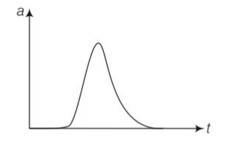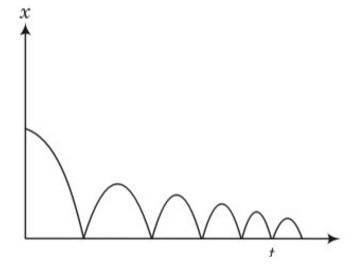Class 11th
Get insights from 8k questions on Class 11th, answered by students, alumni, and experts. You may also ask and answer any question you like about Class 11th
Follow Ask QuestionQuestions
Discussions
Active Users
Followers
New answer posted
5 months agoContributor-Level 10
This is a short answer type question as classified in NCERT Exemplar
When the ball dropped from the building u1=0, u2=40m/s
Velocity of the dropped ball after time t
V1=u1+gt
V1 = gt
For ball thrown up u2=40m/s
Velocity of the ball after time t
V2=u2-gt
=40-gt
Relative velocity =v1-v2
=gt- [-40-gt]=40m/s
New answer posted
5 months agoContributor-Level 10
This is a short answer type question as classified in NCERT Exemplar
speed of first car = 18km/h
Speed of second car = 27km/hr relative with respect to each other is 18+27=45km/h
Distance between cars = 36km
Time = 36/45=0.8h
Distance covered by bird = 36 (0.8)=28.8km
New answer posted
5 months agoContributor-Level 10
This is a short answer type question as classified in NCERT Exemplar
(a) x (t)=x0 (1- )
V (t)=dx/dt= x (t)=x0 ( )
A (t)= x ( t)=x0 ( )
(b) when t=o x (t)= x (t)=x0 (1- )= x (t)=x0 (1-1)=0
x (t) is maximum when t=
x (t) is maximum when t=
v (t) is maximum when t= , v (0)=x0
v (t) is maximum when t= v ( )=0
a (t) is maximum when t= , a ( )=0
a (t) is maximum when t= , a ( )=-x0 2
New answer posted
5 months agoContributor-Level 10
This is a short answer type question as classified in NCERT Exemplar
It is clear from the graph that displacement x is positive throughout . ball is dropped from height and its velocity increases in downward direction due to gravity pull. In this condition v isnegative but acceleration of the ball equal to acceleration due to gravity.
velocity time graph

Acceleration time graph

New answer posted
5 months agoContributor-Level 10
This is a short answer type question as classified in NCERT Exemplar
When speed becomes constant then acceleration will be zero
a=dv/dt=0
But here a=g-bv
Clearly from above equation as speed increases acceleration will decrease . at a certain speed say vo, acceleration will be zero and speed will remain constant.
Hence So g=bv
so v= g/b
New answer posted
5 months agoContributor-Level 10
This is a short answer type question as classified in NCERT Exemplar
x (t)=A+B
Let A>B and
Now velocity is equal to x (t)=dx/dt=-B
So a (t)= dv/dt= B
Above condition are satisfied by the equation.
New answer posted
5 months agoContributor-Level 10
This is a short answer type question as classified in NCERT Exemplar
(a) The equation we use here is x= 1-sint
So velocity = dx/dt=1-cost
Acceleration =sint
When t=o x=o
When t=, x=
When t=0.x= 2
(b) x=sint so velocity becomes v=cost as displacement and velocity contain sin and cos so equation is periodic.
New answer posted
5 months agoContributor-Level 10
This is a short answer type question as classified in NCERT Exemplar
If effect of gravity is neglected then ball moving uniformly turned back with same speed when a ball hit it. Acceleration of the ball is zero just before it hits the bat and due to the repulsive force it gets accelerated.

New answer posted
5 months agoContributor-Level 10
This is a short answer type question as classified in NCERT Exemplar
We have to analyse slope of each curve i.e= dx/dt . for peak values dx/dt will be zero as x is maximum at peak points.
For graph (a) there is appoint for which displacement is zero so a matches with (iii)
In graph b, x is positive throughout and at point B, V=dx/dt=0
Since at point of curvature changes a=0, so b matches with (ii)
displacement is zero in only first graph so it matches with the (iii) point.
And slope of d graph v=dx/dt is positive so v>0 so acceleration will be negative so matches with I but in graph c it matches with iv as its slope is negative.
New question posted
5 months agoTaking an Exam? Selecting a College?
Get authentic answers from experts, students and alumni that you won't find anywhere else
Sign Up on ShikshaOn Shiksha, get access to
- 65k Colleges
- 1.2k Exams
- 679k Reviews
- 1800k Answers


